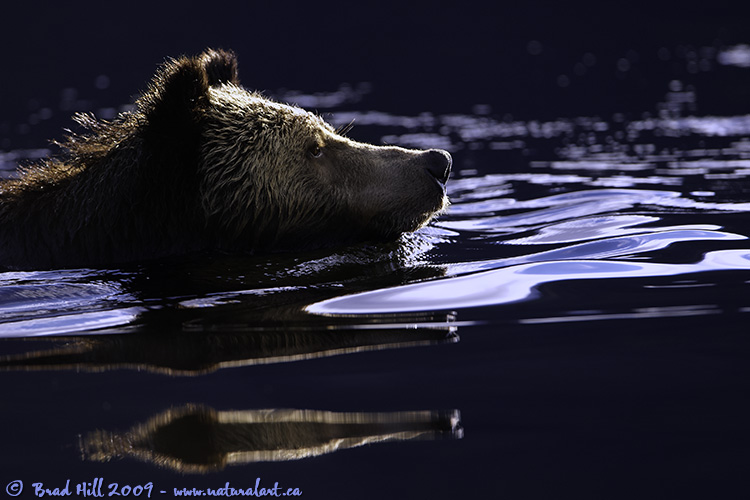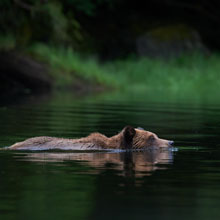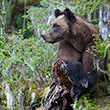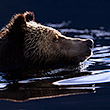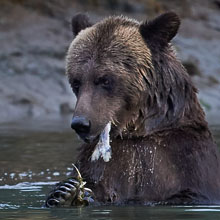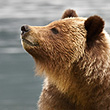In the Field
Early Evening Cruise in the Great Bear Rainforest. Great Bear Rainforest (northern BC coast). October 9, 2008.
I'm a big fan of "atypical" lighting - pretty much anything but direct front-lighting. Side-lighting, back-lighting, side/back-lighting, etc. - you name it. This scene was strongly backlit (and slightly top-lit) and was an unforgettable moment. The bear (a large female grizzly) was crossing an inlet in the early evening - not long before the sun slid behind the high rock walls of the inlet. We were slowly "trolling" in a small zodiac and traveling pretty much parallel to the bear. When the sun illuminated the hair along the top of the bear's head and snout I pointed my way-too-heavy 600 mm "cannon" at the bear and began shooting.
From a technical perspective, capture this image was a real exposure challenge, with the key issue being to choose an exposure that left me enough highlight detail to work with during raw conversion yet didn't kill all the shadow detail. So...how do you decide in the field how to expose these kind of tricky scenes? Read on...
One of the most commonly cited reasons why many photographers enjoy shooting digitally is the immediate feedback you get in the field (image review, histograms, etc.). Not only can you instantly adjust your camera's settings to get a "better" image, but you can instantly learn from your mistakes. I agree with the value of the "instant feedback", but would argue that what you learn LATER (while behind your computer) is even MORE important. For instance, in this image I had to expose for the highlights and later retrieve shadow detail (while processing the raw file and then correcting the image in Photoshop). But...how do you know (in this case) how much to underexpose your image (to retain highlight detail) and how do you know how much shadow detail can be recovered? If you're a raw shooter you can't simply rely on the playback of the image and histogram - they're based on a JPEG preview and NOT the raw image data. And...even if you do blow out the highlight detail somewhat, you can retrieve some of that detail when converting your raw file (how much you can retrieve is partly a function of your skills and partly a function of the raw converter you use). On the other end of the brightness spectrum - how much shadow detail can you extract from your image without adding too much noise to your image? The answers to all these questions come to you during those long hours spent in post-processing sessions behind your computer. The big trick is in applying the knowledge you pick up behind the computer to subsequent field sessions - what you learn behind the computer SHOULD influence what you do behind your camera! I'm always amazed by how many good shooters (especially ex-film shooters, including many pros) ignore this fact and fail to maximize the quality of the image data they capture in the field! So...don't look at all that time spent behind your computer as a penance you have to pay in our brave new world. Instead, view it as a way to improve your image-capture techniques and as a way to improve the quality of your final images!
This image was captured during my annual "Spirit Bears and the Great Bear Rainforest" Photo Tour in the autumn of 2008. If you're interested in joining me on one of my photo tours into the Great Bear Rainforest, check out the details on my "Photo Tours" page. My Instructional Photo Tours into the Great Bear Rainforest are run in conjunction with Ocean Light II Adventures - they offer a number of amazing adventure tours (including top-notch bear-viewing tours as well as tours of exploration of the Queen Charlotte Islands) and I highly recommend them!
Behind the Camera
Early Evening Cruise in the Great Bear Rainforest. Great Bear Rainforest (northern BC coast). October 9, 2008.
Digital Capture; Compressed RAW (NEF) 14-bit format; ISO 200.
Nikon D700 with AF-S Nikkor 600mm f/4G IF-ED II VR lens - handheld in floating Zodiac inflatable boat. VR turned to "On" and in "Normal" mode. Autofocus set to M/a mode.
1/500s @ f5; -0.67 stop compensation from matrix-metered exposure setting.
At the Computer
Early Evening Cruise in the Great Bear Rainforest. Great Bear Rainforest (northern BC coast). October 9, 2008.
RAW Conversion to 16-bit TIFF, including first-pass/capture sharpening, white balance adjustment and slight highlight recovery adjustment using Phase One's Capture One Pro 4.5. Multiple RAW conversions (3 at different exposure settings: 0 stops for for "base" exposure, including water and much of the bear; -1 stops to retrieve highlight detail on rim of bear, and +0.52 stops to retrieve shadow detail on shaded portion of bear's head).
Further digital corrections on 16-bit TIFF file using Adobe's Photoshop CS4. Adjustments included compositing and masking of all 3 exposure versions, selective colour saturation and desaturation, selective curves adjustment and selective sharpening for web output.
Conservation
Early Evening Cruise in the Great Bear Rainforest. Great Bear Rainforest (northern BC coast). October 9, 2008.
Ten percent of the revenue generated by this image will be donated to Raincoast*.
Species Status in Canada**: Special Concern (May 2002).
While Grizzly Bears (Ursus arctos) are not technically listed as "Endangered" in Canada, they have been extirpated from most of their historical range. Grizzly Bears are far more sensitive to intrusion/disturbance in their habitat than are Black Bears and are being increasingly forced into marginal habitat by human encroachment. The Great Bear Rainforest along the central and northern coast of British Columbia is one of the last strongholds of the Grizzly Bear in Canada, and even this population is coming under increasing pressure.
On December 18, 2017 the government of British Columbia banned grizzly hunting across the entire province. This major conservation victory came after decades of tireless work by many dedicated conservationists and ecologists and, most importantly, it reflects the opinion of the vast majority of British Columbians. And, it means that AT LEAST while the current government remains in power grizzlies are finally "safe" in British Columbia.
Now that we've at least temporarily won the battle to save grizzlies in BC, it's time to re-focus our efforts toward protecting ALL of BC's carnivores, including Gray Wolves, Black Bears, Cougars, Wolverines, and more! Simply put, there are no ecological, economic, or ethical arguments supporting the trophy hunting of carnivores.
In a great first step towards ending the hunting of carnivores throughout BC the Raincoast Conservation Foundation has developed a program designed to protect ALL carnivores within the Great Bear Rainforest. Details about this program can be found on this page on Raincoast's website. Check it out and, better yet, make a donation to help Raincoast purchase the remaining commercial hunting tenures in the Great Bear!
*The Raincoast Conservation Society (and Foundation) is an effective and efficient organization that has been fighting for protection of this unique habitat. If you are looking for a meaningful way to contribute to the conservation of this amazing ecosystem, Raincoast will provide maximal "bang" for your conservation dollars.
**as determined by COSEWIC: The Committee on the Status of Endangered Wildlife in Canada












